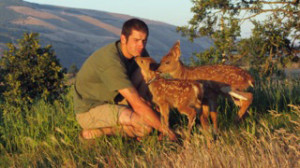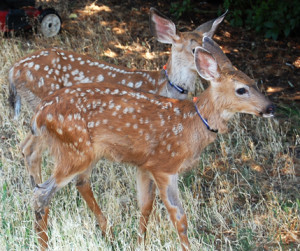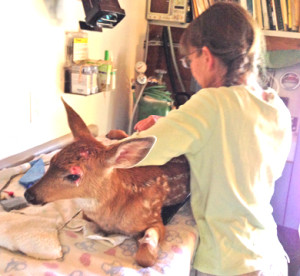By Tracie Hornung
Bruno the fawn got lucky when a caring woman named Jane rescued him moments after he’d had the worst luck of his young life: he’d been hit by a car.
Jane saw the baby deer lying in the middle of the road, unable to move. As she ran over to pick him up and move him into the grass, she saw what she assumed to be his mother and sibling watching her.
Jane called Rowena Wildlife Clinic and explained the situation with the injured fawn, including the fact that she was driving alone. But Dr. Jean Cypher told her if the fawn had a broken leg, which seemed probable, it would be fairly easy to transport him in her car.
Jane swaddled the fawn in a towel to keep him calm, put him on her lap and hoped for the best as she drove the nearly 30 miles to the clinic. They arrived safely at the clinic but, said Jane, “It was quite challenging driving with a baby deer in my lap!”
When Dr. Cypher saw the fawn she could tell he was in shock and that he had not one, but two, broken legs. He had a left tibial fracture and a right heel fracture, rendering the Achilles tendon useless. And he’d also lost the tip of his tail.
“The surgery was a long one,” said Dr. Cypher, “done in two stages over the next few days. Initially we pinned the left leg and also tunneled some wire under the muscle and tendon of the right heel, looping it around some pins driven into the right prominence of the heel. It was a four-handed repair − my assistant Elijah had to help, and his mechanical experience was pretty useful.”
Bruno was able to stand the evening after surgery, but the right leg was painful and he tried to put his weight on the left leg.
“However, that leg made an awful grinding noise when he used it,” said Dr. Cypher, adding that he needed additional pins to keep the lower bones from rotating around the internal and medial pins.
“So I anesthetized him again a few days later, and drove pins from the outside and the front of the leg, attaching the frame to the previous pins. Once the left leg was stable, it was painful, as is usually the case if you have to drive pins through the large muscles on the outside of the leg. Luckily by then, the right leg was increasingly useful to him. He started to do short three-legged walks outside over the next three weeks.”

This photo of Bruno and another fawn patient was taken halfway through Bruno’s healing. Dr. Jean Cypher photo.
About a month later, said Dr. Cypher, he started to act as if he was in pain again and was reluctant to walk.
“This was a sign that some of the hardware needed to be removed. An x-ray sort of indicated that all was healing − although my antiquated machine leaves many caveats! It was a terrible ordeal for me to remove the pins and wires from his right ankle. Bets, who was volunteering that day, agreed with me that it looked as if I was completely dissecting his leg to find and cut out the hardware. But amazingly, he felt better and was completely weight-bearing on that leg again within a couple of days.”

Bruno (foreground) today. You can see the scars on his legs but he is growing into a healthy adolescent! Dr. Cypher puts reflective collars on the fawns so that they can be found in the dark if they don’t go back to the fawn pen at night by themselves. Tracie Hornung photo.
Dr. Cypher removed the pins from the left leg over the next couple of weeks and then Bruno began his final recovery. Now he spends his days outside with other recovering fawn patients and his evenings in the fawn pen. He stands three-legged, but will use his left leg when climbing hills or running (slowly).
“I think he’ll have a normal gait in a year or so,” said Dr. Cypher.
And with Bruno’s luck, you can just bet he will.

